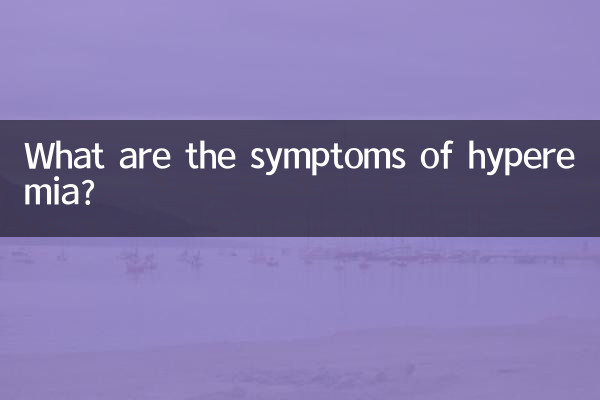What are the symptoms of hyperemia?
Hyperemia, also known as hyperlipidemia, refers to a metabolic disease in which the levels of lipids (such as cholesterol, triglycerides, etc.) in the blood are abnormally elevated. In recent years, with changes in lifestyle, the incidence of hyperemia has gradually increased, becoming an important issue threatening public health. This article will combine the hot topics and hot content on the Internet in the past 10 days to give you a detailed introduction to the symptoms, dangers and preventive measures of hyperemia.
1. Common symptoms of hyperemia

Hyperemia may have no obvious symptoms in the early stages, but as the disease progresses, the following symptoms may appear:
| symptom | describe |
|---|---|
| Dizziness | The blood viscosity increases, resulting in insufficient blood supply to the brain and causing dizziness. |
| Chest tightness | Excessive blood lipids may affect the blood supply to the heart, causing chest tightness or chest pain. |
| numbness in limbs | Poor blood circulation may cause numbness or tingling in the hands and feet. |
| blurred vision | Hyperlipidemia may cause retinal vascular disease and affect vision. |
| Cutaneous xanthomas | Yellow nodules appear on the skin, often on eyelids, joints, etc. |
2. Dangers of Hyperemia
If hyperemia is not intervened in time, it may cause a variety of serious complications:
| complication | risk |
|---|---|
| atherosclerosis | Blood lipids deposit on blood vessel walls, causing blood vessels to narrow or become blocked. |
| coronary heart disease | Insufficient blood supply to the heart increases the risk of myocardial infarction. |
| stroke | Cerebrovascular disease may lead to cerebral hemorrhage or cerebral infarction. |
| pancreatitis | Excessive triglycerides may induce acute pancreatitis. |
3. Prevention and treatment of hyperemia
Preventing and treating hyperemia requires both lifestyle and medical intervention:
| measure | Specific content |
|---|---|
| diet modification | Reduce high-fat and high-sugar foods and increase dietary fiber intake. |
| sports | At least 150 minutes of moderate-intensity aerobic exercise per week, such as brisk walking and swimming. |
| Quit smoking and limit alcohol | Smoking and excessive alcohol consumption can aggravate dyslipidemia. |
| drug treatment | Use lipid-lowering drugs such as statins and fibrates under the guidance of a doctor. |
4. Topics related to hyperemia that are hotly discussed on the Internet
In the past 10 days, discussions about hyperemia have mainly focused on the following aspects:
1.The incidence of hyperemia in young people is rising: Data show that the detection rate of hyperemia in people under 30 years old is increasing year by year, which is closely related to bad habits such as staying up late and eating takeout.
2.The relationship between hyperemia and sequelae of COVID-19: Some studies have pointed out that COVID-19 infection may aggravate abnormal blood lipid metabolism, and we need to be alert to the cardiovascular impact of "long COVID-19".
3.Progress in new lipid-lowering drugs: New drugs such as PCSK9 inhibitors have outstanding performance in reducing low-density lipoprotein cholesterol (LDL-C) and have become the focus of the medical community.
5. Summary
Hyperemia is a "silent killer" with no obvious early symptoms but great harm. Hypertension can be effectively prevented and controlled through regular physical examinations, healthy diet, and regular exercise. If you have the above symptoms, it is recommended to seek medical examination in time to avoid worsening of the condition.
The content of this article synthesizes recent medical research and Internet hot topics, aiming to improve public awareness of hyperemia. A healthy life starts with paying attention to blood lipids!

check the details

check the details